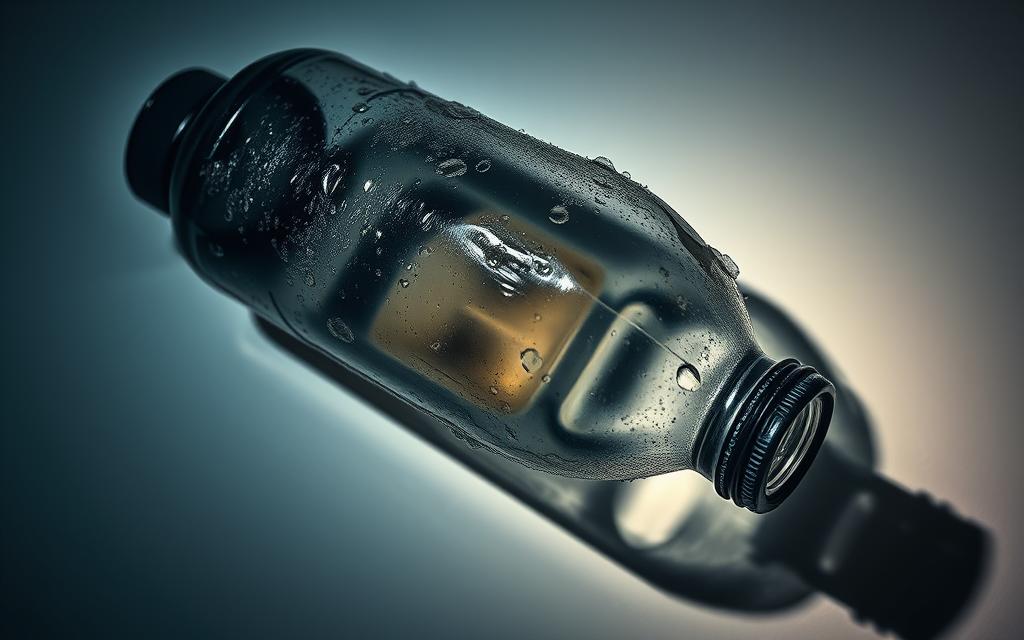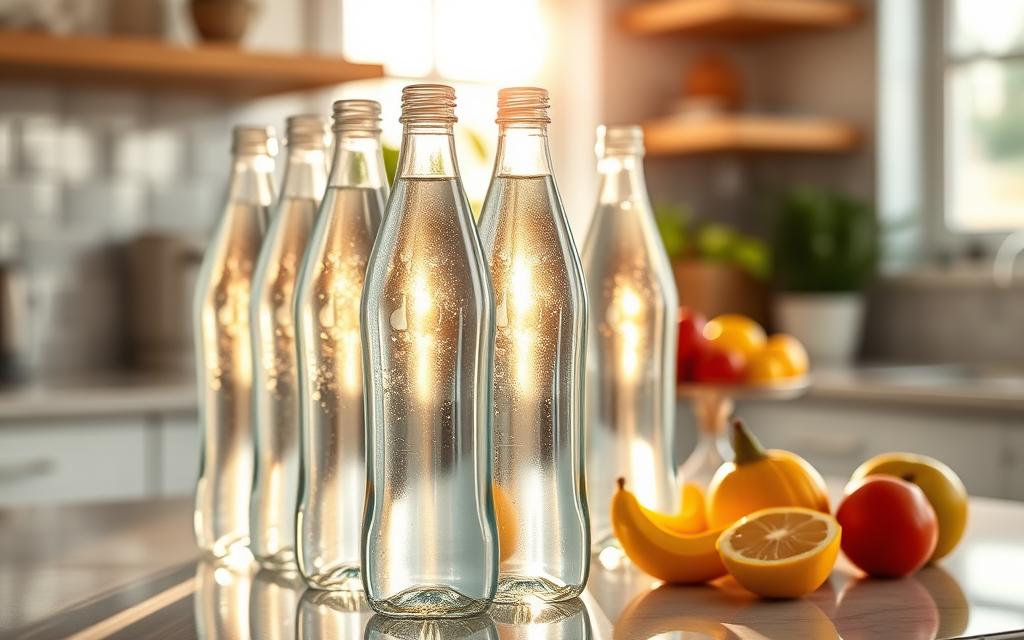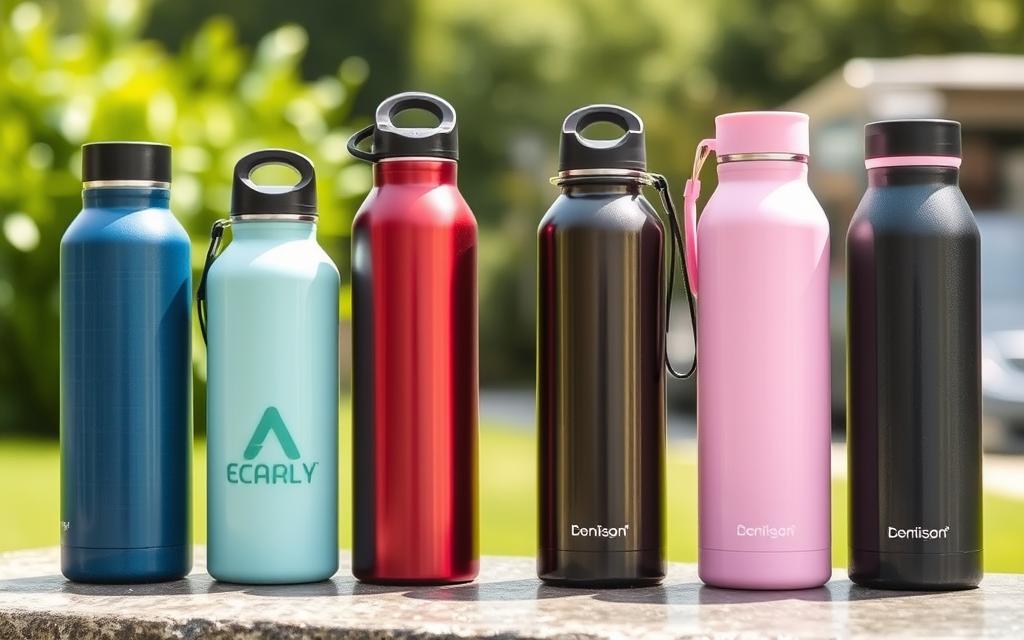Ever thought your water bottle might be more than just a drink holder? Could it be a source of strep throat? It’s a scary thought, but it’s something to consider.
Reusable water bottles are a big deal in our health-focused lives. But can they spread strep throat? Yes, they can. Germs and bacteria can grow fast in these bottles, making them a health risk.
As someone always on the move, I found out dirty water bottles are more than a hassle. They can be a serious health danger. I learned that dirty bottles can host harmful bacteria, leading to strep throat and other infections.
Key Takeaways
- Dirty water bottles can harbor dangerous bacteria
- Regular cleaning is key to avoiding infections
- Strep throat can spread through dirty drinking vessels
- Not all water bottles are the same in terms of cleanliness
- Simple cleaning can greatly lower health risks
Understanding Strep Throat and Its Causes
Strep throat might seem like a simple illness, but it’s a complex bacterial infection. It can quickly disrupt your daily life. As someone who’s battled this uncomfortable condition, I want to help you understand its core mechanics and how it spreads.

Strep throat is caused by group A streptococcus bacteria. These tiny invaders can turn a normal day into a painful experience. Symptoms make swallowing feel like a challenge.
The Basics of Strep Throat
Understanding strep throat starts with recognizing its primary characteristics:
- Caused by group A streptococcus bacteria
- Highly contagious respiratory infection
- Primarily affects the throat and tonsils
- Common among children and teenagers
How Strep Transmission Occurs
Strep throat can spread through multiple channels, including a dirty water bottle. Close contact with infected individuals creates prime conditions for transmission. Respiratory droplets, shared utensils, and contaminated surfaces like water bottles become breeding grounds for strep bacteria.
“Prevention is always better than cure when it comes to strep throat transmission.” – Medical Health Professionals
A dirty water bottle can become an unexpected vector for strep transmission. Bacteria thrive in moist environments. Unwashed bottles are perfect habitats for harmful microorganisms that cause strep throat.
- Respiratory droplets spread infection
- Shared personal items increase transmission risk
- Contaminated surfaces contribute to bacterial spread
By understanding how strep throat spreads, you can take proactive steps. Protect yourself and those around you from this uncomfortable bacterial infection.
My Dirty Water Bottle: A Source of Infection
I never thought my water bottle could be a breeding ground for dangerous bacteria. Learning about the health risks made me realize how important it is to know about the tiny world in our drinking containers.
My research showed me how water bottles can hide harmful germs. Reusable water bottles can become unexpected homes for dangerous microorganisms that can harm our health.
Common Germs Hiding in Your Water Bottle
Water bottles can hide many dangerous bacteria, including:
- Coliform bacteria
- Strep bacteria
- E. coli
- Staphylococcus
Frequency of Bacterial Contamination
Studies show that strep bacteria in water bottles is more common than we think. About 60% of reusable water bottles have a lot of bacterial growth if they’re not cleaned well.
The inside of water bottles is warm and moist, perfect for bacteria to grow. Not cleaning it often, not drying it well, and handling it a lot can increase the risk of getting contaminated.
Regular cleaning and proper maintenance are key to stopping bacteria in your water bottle.
Knowing these risks changed how I take care of my water bottle. By cleaning it regularly and properly, I’ve lowered my chance of getting sick from harmful bacteria.
Signs and Symptoms of Strep Throat
Strep throat can catch you off guard, making water bottle sharing a risk. Spotting symptoms early is key. It helps you act fast and stop the spread to others.
Identifying the Warning Signs
My experience with strep throat showed me to watch for certain signs. The classic symptoms include:
- Sudden, severe sore throat
- High fever (typically over 101°F)
- Painful swallowing
- Red and swollen tonsils, sometimes with white patches
- Tender, swollen lymph nodes in the neck
When Professional Help Becomes Critical
Not all sore throats are the same. I learned to see a doctor when:
- Fever lasts more than 48 hours
- Throat pain gets worse
- It’s hard to breathe or swallow
- Symptoms don’t get better after a few days
Pro tip: A rapid strep test can confirm the diagnosis fast. It helps avoid complications from untreated streptococcus infections.
Early detection and treatment can make a big difference. It helps you recover faster and stops the infection from spreading.
The Role of Hydration in Maintaining Health
Staying hydrated is key for our health and immune system. Water helps our body work well and fight off illnesses like strep throat. Using a clean water bottle is a smart way to support our immune system.
Learning about hydration opened my eyes. It’s not just about drinking when we’re thirsty. It’s a basic part of staying healthy. Clean water helps fight infections, unlike dirty water bottles that can spread strep.
Importance of Drinking Water
Drinking enough water does more than just quench our thirst. It’s vital for our health. Here’s why:
- Supports immune system function
- Helps flush out toxins
- Maintains optimal body temperature
- Improves cognitive performance
How Clean Water Supports Immune Function
Clean water stops bacteria that cause strep throat. A clean water bottle lowers the chance of getting sick. It’s important to keep your water bottle clean to avoid strep.
The Mayo Clinic recommends drinking eight glasses of water daily to maintain optimal health.
To avoid strep from dirty water bottles, clean your bottle often. Use hot water and mild soap, and dry it well. This simple step can protect your health.
Cleaning and Maintaining My Water Bottle
Keeping your water bottle clean is key to avoid health risks like strep throat. I learned that proper care is essential to stay healthy.
Learning how to clean your water bottle can lower the risk of strep throat. Experts say to clean it regularly, not just a quick rinse.
Essential Cleaning Practices
- Wash your water bottle daily with hot, soapy water
- Use a bottle brush to reach all interior surfaces
- Rinse thoroughly to remove all soap residue
- Allow the bottle to air dry completely
Recommended Cleaning Products
| Bottle Material | Best Cleaning Method | Recommended Product |
|---|---|---|
| Stainless Steel | Mild dish soap, bottle brush | Bottle Bright Cleaning Tablets |
| Glass | White vinegar solution | Dr. Bronner’s Pure-Castile Soap |
| Plastic | Specialized bottle cleaner | OXO Water Bottle Cleaning Set |
“A clean water bottle is your first defense against harmful bacteria” – Health Experts
Stainless steel and glass bottles are easier to clean and less likely to grow bacteria. By following these cleaning tips, you can lower the risk of strep throat and other infections from a dirty water bottle.
Risks of Sharing Water Bottles
Sharing water bottles might seem harmless, but it can be risky. My research showed some surprising facts about health risks from this common practice.
The truth about strep bacteria in water bottles is alarming. Bacteria can spread easily through shared bottles. This creates a perfect setting for infectious germs.
Understanding Contagion Risks
Strep bacteria in water bottles is a serious issue. Several factors increase the risk of transmission:
- Direct mouth contact with bottle openings
- Moisture creating ideal bacterial growth conditions
- Extended time between cleanings
Potential Transmission Pathways
| Sharing Method | Infection Risk | Recommended Action |
|---|---|---|
| Direct Mouth Contact | High | Avoid Completely |
| Touching Bottle Rim | Moderate | Sanitize Immediately |
| Indirect Contact | Low | Clean Thoroughly |
Encouraging Healthy Habits
To avoid infections, adopt simple hygiene practices:
- Never share your water bottle
- Clean bottles regularly with hot water
- Use personal water containers
- Replace bottles every few months
Your health is worth more than momentary convenience. Stay vigilant about your hydration habits!
Preventing Strep Throat: More Than Just Hygiene
Stopping strep throat is more than just cleaning a water bottle. It’s about using many health strategies together. These help make your body stronger against infections.
To stop strep from spreading, you need a whole health plan. Your immune system is key in fighting off infections like strep throat.
The Power of Hand Hygiene
Handwashing is a top way to avoid getting sick. Here’s how to do it right:
- Wash hands for at least 20 seconds
- Use soap and warm water
- Scrub all hand surfaces thoroughly
- Dry hands completely with a clean towel
“Clean hands are your first line of defense against infectious diseases.” – CDC Health Guidelines
Boosting Immune Support
A strong immune system fights off strep infections well. Here are ways to boost your immune system:
| Strategy | Benefit |
|---|---|
| Regular Exercise | Enhances immune response |
| Balanced Diet | Provides essential nutrients |
| Adequate Sleep | Supports immune system recovery |
| Stress Management | Reduces immune system strain |
Vaccination can provide additional protection against certain bacterial infections. Talk to your doctor about vaccines that can help prevent strep-related illnesses.
My Personal Experience with Strep Throat
My journey with streptococcus from water bottles was a real eye-opener. It changed how I think about personal hygiene. At first, I kept getting sore throats. But then, I realized my water bottle might be the problem.
Discovering the Hidden Risks
I never thought a simple water bottle could harbor bacteria. But, yes, strep can spread through water bottles. My own research showed me some scary facts:
- Bacteria grow fast in damp places
- Not cleaning often lets streptococcus thrive
- Sharing bottles raises the risk of getting sick
My Strategy for Prevention
Once I knew the risks, I made a plan to keep my water bottle clean:
- Wash it every day with hot, soapy water
- Use a bottle brush for tough spots
- Let it dry completely before using it again
- Change bottles every few months
- Never lend out my water bottle
By following these steps, I cut down my risk of strep throat and boosted my health.
Conclusion: Staying Healthy in a Germ-Filled World
Exploring water bottle hygiene has shown us how to avoid strep throat. Yes, you can get strep from a dirty water bottle. Studies show how bacteria can turn our water bottles into health hazards.
Keeping your water bottle clean is key. Dirty water bottles can spread strep more than we think. Simple steps like washing bottles with hot, soapy water and drying them well can stop bacteria.
Staying healthy doesn’t mean living in constant fear. By cleaning our drinking containers, washing our hands, and being careful with our water bottles, we can make a big difference. Knowing the risks and taking smart steps can turn our daily items into health protectors.
This journey has taught me a vital lesson: being aware and taking care of ourselves is our best defense against health problems. Clean water bottles are more than just pretty; they’re our shield against germs in a world full of them.



